Critical Evaluation and Analysis of Tesco's Annual Report
VerifiedAdded on 2022/12/09
|14
|3019
|445
AI Summary
This study critically evaluates and analyzes the annual report of Tesco, including its business model, risks faced, significant issues raised by auditors, and performance under IFRS. It also assesses the overall performance of the annual report with proper justification.
Contribute Materials
Your contribution can guide someone’s learning journey. Share your
documents today.

Accounting financial analysis report
Secure Best Marks with AI Grader
Need help grading? Try our AI Grader for instant feedback on your assignments.
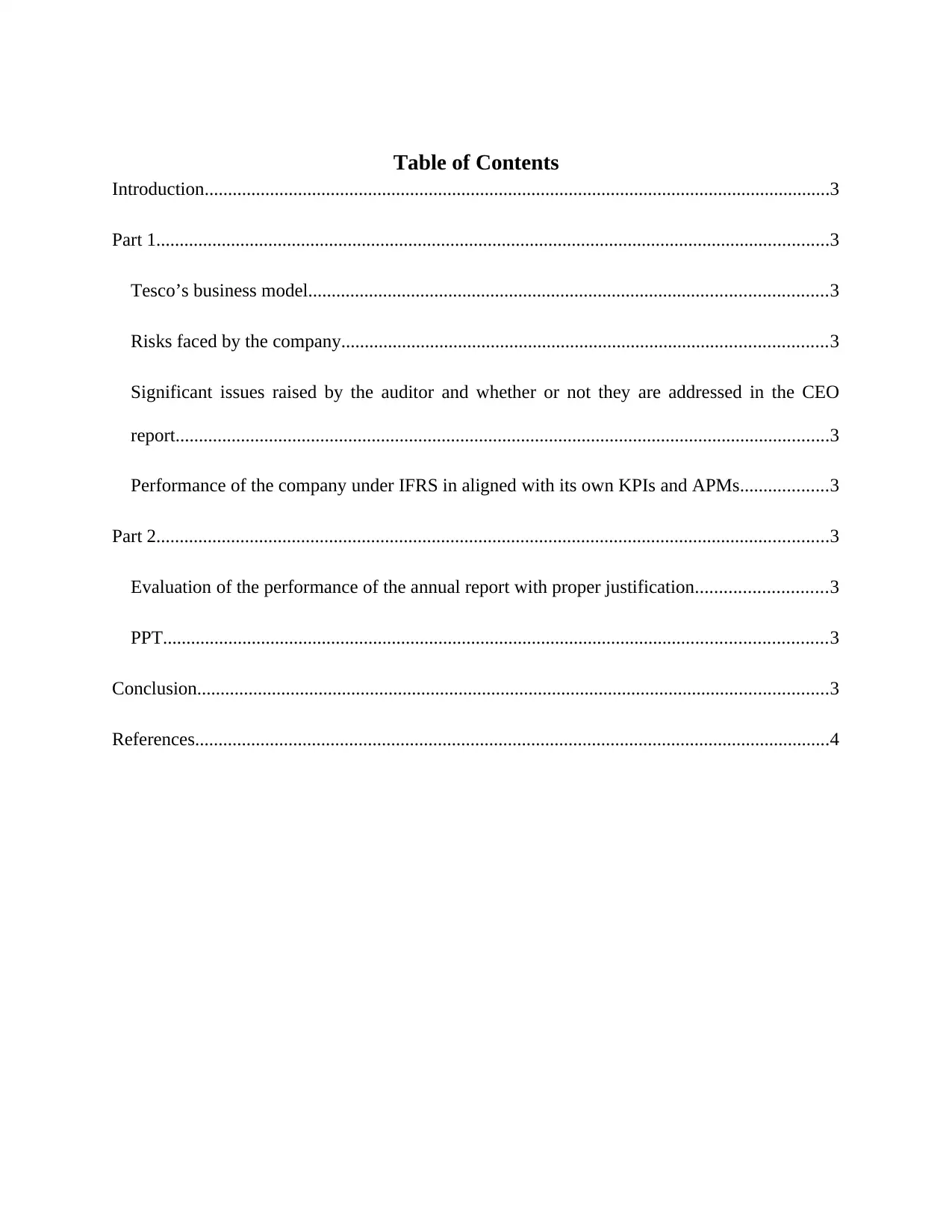
Table of Contents
Introduction......................................................................................................................................3
Part 1................................................................................................................................................3
Tesco’s business model...............................................................................................................3
Risks faced by the company........................................................................................................3
Significant issues raised by the auditor and whether or not they are addressed in the CEO
report............................................................................................................................................3
Performance of the company under IFRS in aligned with its own KPIs and APMs...................3
Part 2................................................................................................................................................3
Evaluation of the performance of the annual report with proper justification............................3
PPT..............................................................................................................................................3
Conclusion.......................................................................................................................................3
References........................................................................................................................................4
Introduction......................................................................................................................................3
Part 1................................................................................................................................................3
Tesco’s business model...............................................................................................................3
Risks faced by the company........................................................................................................3
Significant issues raised by the auditor and whether or not they are addressed in the CEO
report............................................................................................................................................3
Performance of the company under IFRS in aligned with its own KPIs and APMs...................3
Part 2................................................................................................................................................3
Evaluation of the performance of the annual report with proper justification............................3
PPT..............................................................................................................................................3
Conclusion.......................................................................................................................................3
References........................................................................................................................................4
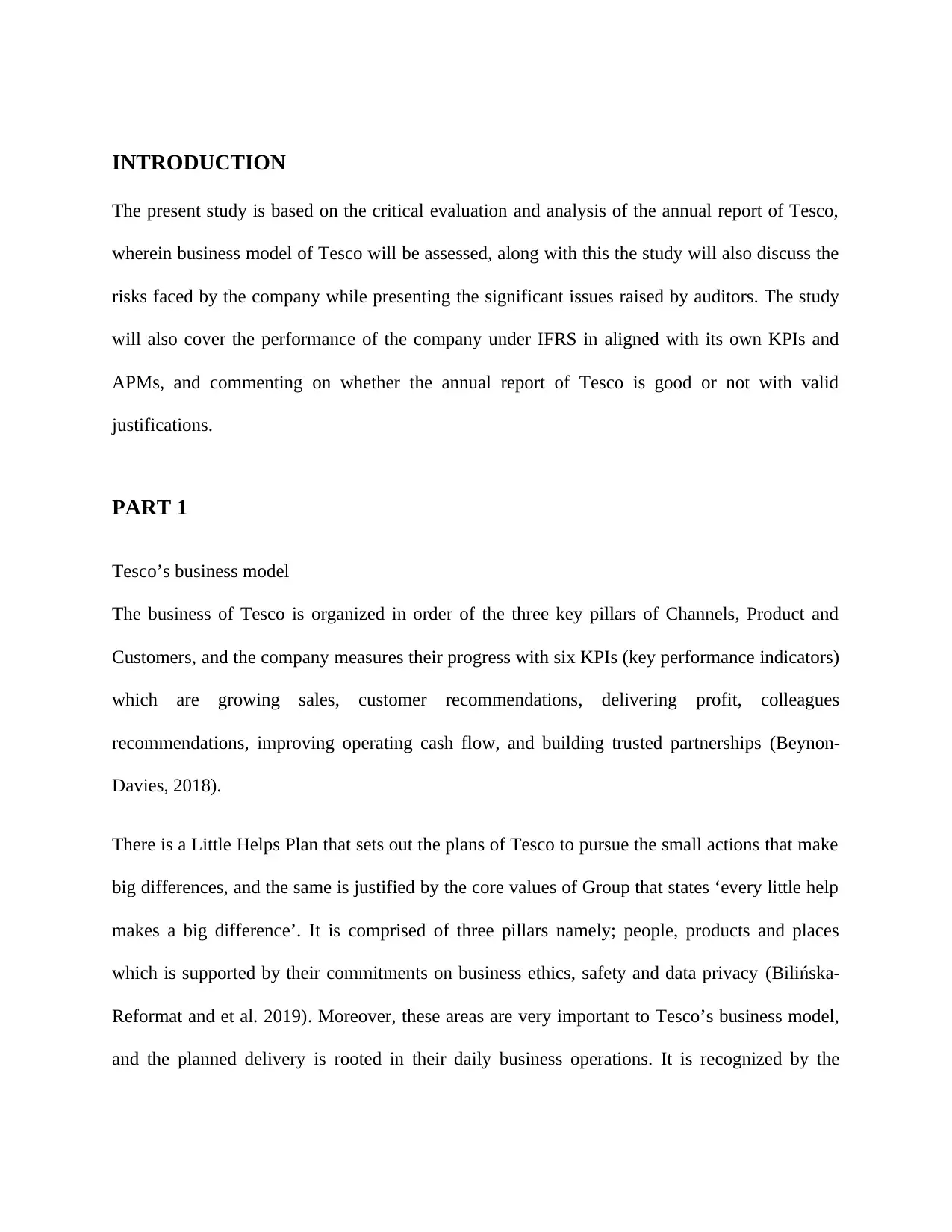
INTRODUCTION
The present study is based on the critical evaluation and analysis of the annual report of Tesco,
wherein business model of Tesco will be assessed, along with this the study will also discuss the
risks faced by the company while presenting the significant issues raised by auditors. The study
will also cover the performance of the company under IFRS in aligned with its own KPIs and
APMs, and commenting on whether the annual report of Tesco is good or not with valid
justifications.
PART 1
Tesco’s business model
The business of Tesco is organized in order of the three key pillars of Channels, Product and
Customers, and the company measures their progress with six KPIs (key performance indicators)
which are growing sales, customer recommendations, delivering profit, colleagues
recommendations, improving operating cash flow, and building trusted partnerships (Beynon-
Davies, 2018).
There is a Little Helps Plan that sets out the plans of Tesco to pursue the small actions that make
big differences, and the same is justified by the core values of Group that states ‘every little help
makes a big difference’. It is comprised of three pillars namely; people, products and places
which is supported by their commitments on business ethics, safety and data privacy (Bilińska-
Reformat and et al. 2019). Moreover, these areas are very important to Tesco’s business model,
and the planned delivery is rooted in their daily business operations. It is recognized by the
The present study is based on the critical evaluation and analysis of the annual report of Tesco,
wherein business model of Tesco will be assessed, along with this the study will also discuss the
risks faced by the company while presenting the significant issues raised by auditors. The study
will also cover the performance of the company under IFRS in aligned with its own KPIs and
APMs, and commenting on whether the annual report of Tesco is good or not with valid
justifications.
PART 1
Tesco’s business model
The business of Tesco is organized in order of the three key pillars of Channels, Product and
Customers, and the company measures their progress with six KPIs (key performance indicators)
which are growing sales, customer recommendations, delivering profit, colleagues
recommendations, improving operating cash flow, and building trusted partnerships (Beynon-
Davies, 2018).
There is a Little Helps Plan that sets out the plans of Tesco to pursue the small actions that make
big differences, and the same is justified by the core values of Group that states ‘every little help
makes a big difference’. It is comprised of three pillars namely; people, products and places
which is supported by their commitments on business ethics, safety and data privacy (Bilińska-
Reformat and et al. 2019). Moreover, these areas are very important to Tesco’s business model,
and the planned delivery is rooted in their daily business operations. It is recognized by the
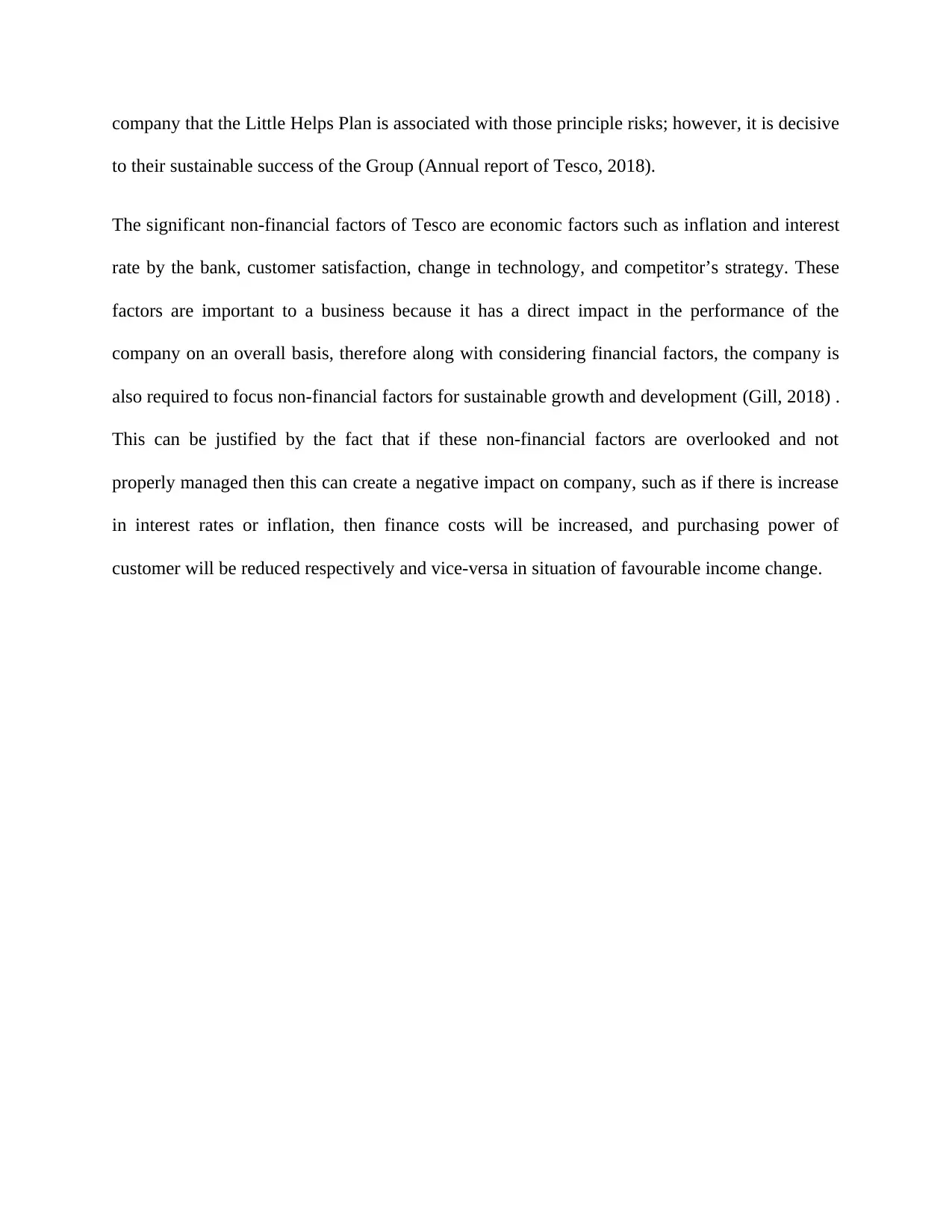
company that the Little Helps Plan is associated with those principle risks; however, it is decisive
to their sustainable success of the Group (Annual report of Tesco, 2018).
The significant non-financial factors of Tesco are economic factors such as inflation and interest
rate by the bank, customer satisfaction, change in technology, and competitor’s strategy. These
factors are important to a business because it has a direct impact in the performance of the
company on an overall basis, therefore along with considering financial factors, the company is
also required to focus non-financial factors for sustainable growth and development (Gill, 2018) .
This can be justified by the fact that if these non-financial factors are overlooked and not
properly managed then this can create a negative impact on company, such as if there is increase
in interest rates or inflation, then finance costs will be increased, and purchasing power of
customer will be reduced respectively and vice-versa in situation of favourable income change.
to their sustainable success of the Group (Annual report of Tesco, 2018).
The significant non-financial factors of Tesco are economic factors such as inflation and interest
rate by the bank, customer satisfaction, change in technology, and competitor’s strategy. These
factors are important to a business because it has a direct impact in the performance of the
company on an overall basis, therefore along with considering financial factors, the company is
also required to focus non-financial factors for sustainable growth and development (Gill, 2018) .
This can be justified by the fact that if these non-financial factors are overlooked and not
properly managed then this can create a negative impact on company, such as if there is increase
in interest rates or inflation, then finance costs will be increased, and purchasing power of
customer will be reduced respectively and vice-versa in situation of favourable income change.
Secure Best Marks with AI Grader
Need help grading? Try our AI Grader for instant feedback on your assignments.
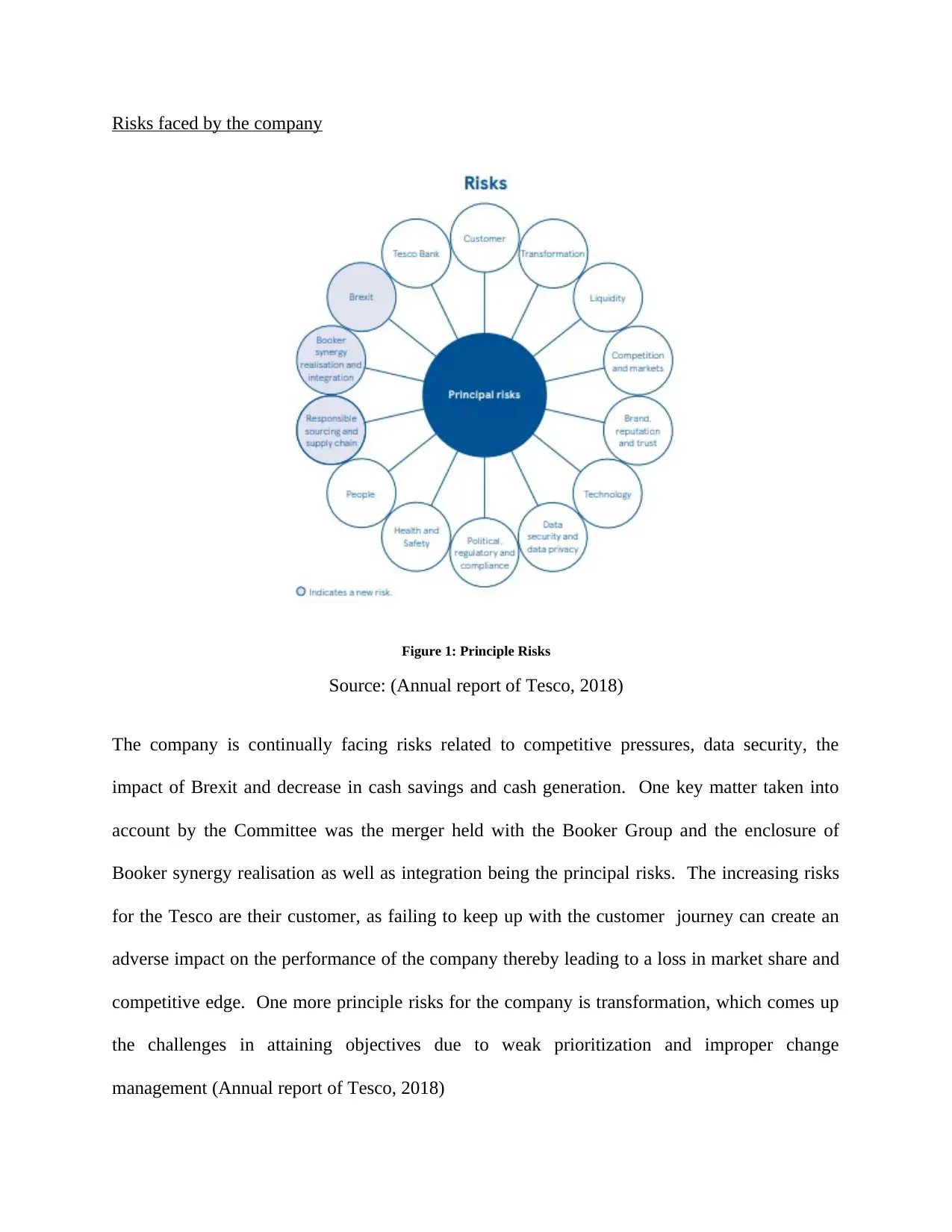
Risks faced by the company
Figure 1: Principle Risks
Source: (Annual report of Tesco, 2018)
The company is continually facing risks related to competitive pressures, data security, the
impact of Brexit and decrease in cash savings and cash generation. One key matter taken into
account by the Committee was the merger held with the Booker Group and the enclosure of
Booker synergy realisation as well as integration being the principal risks. The increasing risks
for the Tesco are their customer, as failing to keep up with the customer journey can create an
adverse impact on the performance of the company thereby leading to a loss in market share and
competitive edge. One more principle risks for the company is transformation, which comes up
the challenges in attaining objectives due to weak prioritization and improper change
management (Annual report of Tesco, 2018)
Figure 1: Principle Risks
Source: (Annual report of Tesco, 2018)
The company is continually facing risks related to competitive pressures, data security, the
impact of Brexit and decrease in cash savings and cash generation. One key matter taken into
account by the Committee was the merger held with the Booker Group and the enclosure of
Booker synergy realisation as well as integration being the principal risks. The increasing risks
for the Tesco are their customer, as failing to keep up with the customer journey can create an
adverse impact on the performance of the company thereby leading to a loss in market share and
competitive edge. One more principle risks for the company is transformation, which comes up
the challenges in attaining objectives due to weak prioritization and improper change
management (Annual report of Tesco, 2018)
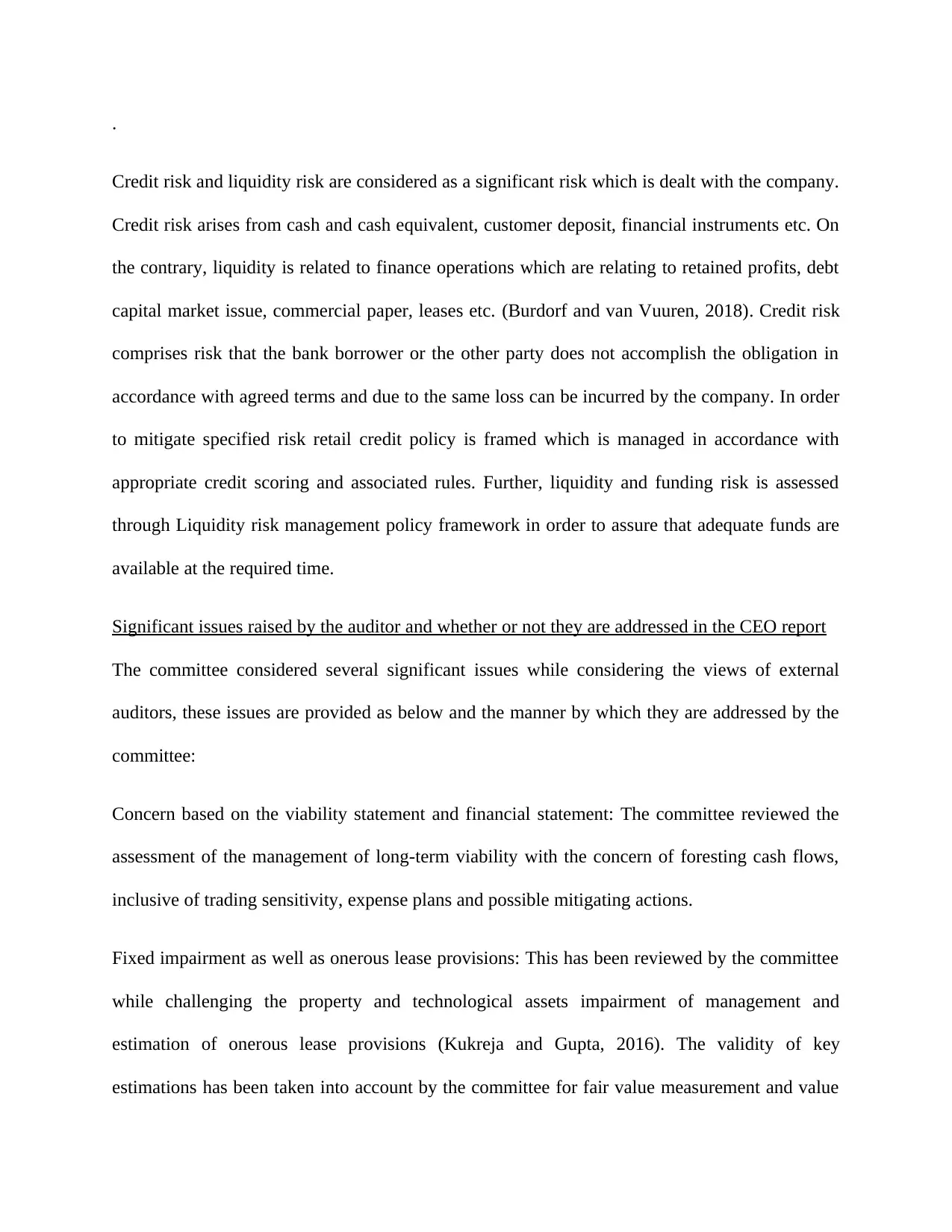
.
Credit risk and liquidity risk are considered as a significant risk which is dealt with the company.
Credit risk arises from cash and cash equivalent, customer deposit, financial instruments etc. On
the contrary, liquidity is related to finance operations which are relating to retained profits, debt
capital market issue, commercial paper, leases etc. (Burdorf and van Vuuren, 2018). Credit risk
comprises risk that the bank borrower or the other party does not accomplish the obligation in
accordance with agreed terms and due to the same loss can be incurred by the company. In order
to mitigate specified risk retail credit policy is framed which is managed in accordance with
appropriate credit scoring and associated rules. Further, liquidity and funding risk is assessed
through Liquidity risk management policy framework in order to assure that adequate funds are
available at the required time.
Significant issues raised by the auditor and whether or not they are addressed in the CEO report
The committee considered several significant issues while considering the views of external
auditors, these issues are provided as below and the manner by which they are addressed by the
committee:
Concern based on the viability statement and financial statement: The committee reviewed the
assessment of the management of long-term viability with the concern of foresting cash flows,
inclusive of trading sensitivity, expense plans and possible mitigating actions.
Fixed impairment as well as onerous lease provisions: This has been reviewed by the committee
while challenging the property and technological assets impairment of management and
estimation of onerous lease provisions (Kukreja and Gupta, 2016). The validity of key
estimations has been taken into account by the committee for fair value measurement and value
Credit risk and liquidity risk are considered as a significant risk which is dealt with the company.
Credit risk arises from cash and cash equivalent, customer deposit, financial instruments etc. On
the contrary, liquidity is related to finance operations which are relating to retained profits, debt
capital market issue, commercial paper, leases etc. (Burdorf and van Vuuren, 2018). Credit risk
comprises risk that the bank borrower or the other party does not accomplish the obligation in
accordance with agreed terms and due to the same loss can be incurred by the company. In order
to mitigate specified risk retail credit policy is framed which is managed in accordance with
appropriate credit scoring and associated rules. Further, liquidity and funding risk is assessed
through Liquidity risk management policy framework in order to assure that adequate funds are
available at the required time.
Significant issues raised by the auditor and whether or not they are addressed in the CEO report
The committee considered several significant issues while considering the views of external
auditors, these issues are provided as below and the manner by which they are addressed by the
committee:
Concern based on the viability statement and financial statement: The committee reviewed the
assessment of the management of long-term viability with the concern of foresting cash flows,
inclusive of trading sensitivity, expense plans and possible mitigating actions.
Fixed impairment as well as onerous lease provisions: This has been reviewed by the committee
while challenging the property and technological assets impairment of management and
estimation of onerous lease provisions (Kukreja and Gupta, 2016). The validity of key
estimations has been taken into account by the committee for fair value measurement and value
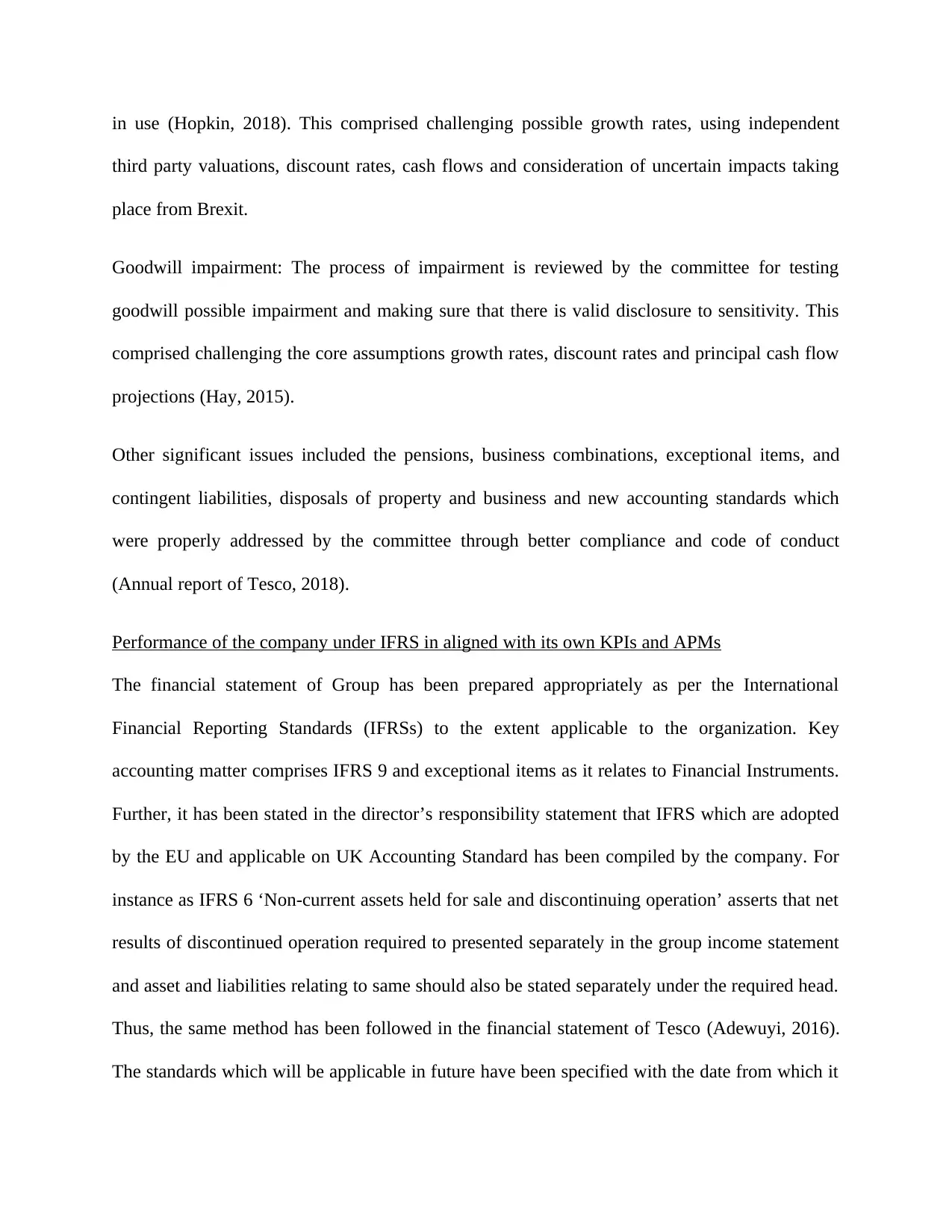
in use (Hopkin, 2018). This comprised challenging possible growth rates, using independent
third party valuations, discount rates, cash flows and consideration of uncertain impacts taking
place from Brexit.
Goodwill impairment: The process of impairment is reviewed by the committee for testing
goodwill possible impairment and making sure that there is valid disclosure to sensitivity. This
comprised challenging the core assumptions growth rates, discount rates and principal cash flow
projections (Hay, 2015).
Other significant issues included the pensions, business combinations, exceptional items, and
contingent liabilities, disposals of property and business and new accounting standards which
were properly addressed by the committee through better compliance and code of conduct
(Annual report of Tesco, 2018).
Performance of the company under IFRS in aligned with its own KPIs and APMs
The financial statement of Group has been prepared appropriately as per the International
Financial Reporting Standards (IFRSs) to the extent applicable to the organization. Key
accounting matter comprises IFRS 9 and exceptional items as it relates to Financial Instruments.
Further, it has been stated in the director’s responsibility statement that IFRS which are adopted
by the EU and applicable on UK Accounting Standard has been compiled by the company. For
instance as IFRS 6 ‘Non-current assets held for sale and discontinuing operation’ asserts that net
results of discontinued operation required to presented separately in the group income statement
and asset and liabilities relating to same should also be stated separately under the required head.
Thus, the same method has been followed in the financial statement of Tesco (Adewuyi, 2016).
The standards which will be applicable in future have been specified with the date from which it
third party valuations, discount rates, cash flows and consideration of uncertain impacts taking
place from Brexit.
Goodwill impairment: The process of impairment is reviewed by the committee for testing
goodwill possible impairment and making sure that there is valid disclosure to sensitivity. This
comprised challenging the core assumptions growth rates, discount rates and principal cash flow
projections (Hay, 2015).
Other significant issues included the pensions, business combinations, exceptional items, and
contingent liabilities, disposals of property and business and new accounting standards which
were properly addressed by the committee through better compliance and code of conduct
(Annual report of Tesco, 2018).
Performance of the company under IFRS in aligned with its own KPIs and APMs
The financial statement of Group has been prepared appropriately as per the International
Financial Reporting Standards (IFRSs) to the extent applicable to the organization. Key
accounting matter comprises IFRS 9 and exceptional items as it relates to Financial Instruments.
Further, it has been stated in the director’s responsibility statement that IFRS which are adopted
by the EU and applicable on UK Accounting Standard has been compiled by the company. For
instance as IFRS 6 ‘Non-current assets held for sale and discontinuing operation’ asserts that net
results of discontinued operation required to presented separately in the group income statement
and asset and liabilities relating to same should also be stated separately under the required head.
Thus, the same method has been followed in the financial statement of Tesco (Adewuyi, 2016).
The standards which will be applicable in future have been specified with the date from which it
Paraphrase This Document
Need a fresh take? Get an instant paraphrase of this document with our AI Paraphraser
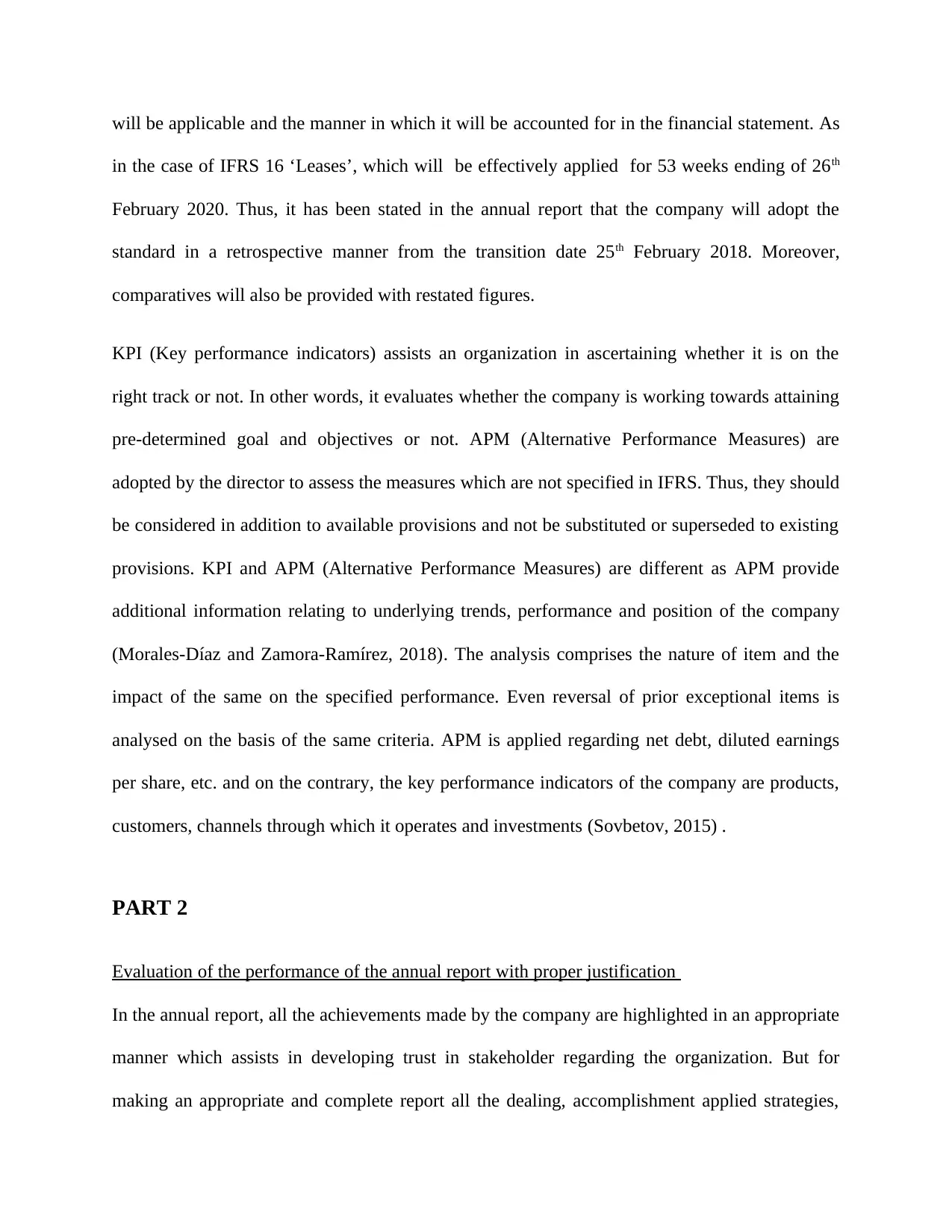
will be applicable and the manner in which it will be accounted for in the financial statement. As
in the case of IFRS 16 ‘Leases’, which will be effectively applied for 53 weeks ending of 26th
February 2020. Thus, it has been stated in the annual report that the company will adopt the
standard in a retrospective manner from the transition date 25th February 2018. Moreover,
comparatives will also be provided with restated figures.
KPI (Key performance indicators) assists an organization in ascertaining whether it is on the
right track or not. In other words, it evaluates whether the company is working towards attaining
pre-determined goal and objectives or not. APM (Alternative Performance Measures) are
adopted by the director to assess the measures which are not specified in IFRS. Thus, they should
be considered in addition to available provisions and not be substituted or superseded to existing
provisions. KPI and APM (Alternative Performance Measures) are different as APM provide
additional information relating to underlying trends, performance and position of the company
(Morales-Díaz and Zamora-Ramírez, 2018). The analysis comprises the nature of item and the
impact of the same on the specified performance. Even reversal of prior exceptional items is
analysed on the basis of the same criteria. APM is applied regarding net debt, diluted earnings
per share, etc. and on the contrary, the key performance indicators of the company are products,
customers, channels through which it operates and investments (Sovbetov, 2015) .
PART 2
Evaluation of the performance of the annual report with proper justification
In the annual report, all the achievements made by the company are highlighted in an appropriate
manner which assists in developing trust in stakeholder regarding the organization. But for
making an appropriate and complete report all the dealing, accomplishment applied strategies,
in the case of IFRS 16 ‘Leases’, which will be effectively applied for 53 weeks ending of 26th
February 2020. Thus, it has been stated in the annual report that the company will adopt the
standard in a retrospective manner from the transition date 25th February 2018. Moreover,
comparatives will also be provided with restated figures.
KPI (Key performance indicators) assists an organization in ascertaining whether it is on the
right track or not. In other words, it evaluates whether the company is working towards attaining
pre-determined goal and objectives or not. APM (Alternative Performance Measures) are
adopted by the director to assess the measures which are not specified in IFRS. Thus, they should
be considered in addition to available provisions and not be substituted or superseded to existing
provisions. KPI and APM (Alternative Performance Measures) are different as APM provide
additional information relating to underlying trends, performance and position of the company
(Morales-Díaz and Zamora-Ramírez, 2018). The analysis comprises the nature of item and the
impact of the same on the specified performance. Even reversal of prior exceptional items is
analysed on the basis of the same criteria. APM is applied regarding net debt, diluted earnings
per share, etc. and on the contrary, the key performance indicators of the company are products,
customers, channels through which it operates and investments (Sovbetov, 2015) .
PART 2
Evaluation of the performance of the annual report with proper justification
In the annual report, all the achievements made by the company are highlighted in an appropriate
manner which assists in developing trust in stakeholder regarding the organization. But for
making an appropriate and complete report all the dealing, accomplishment applied strategies,
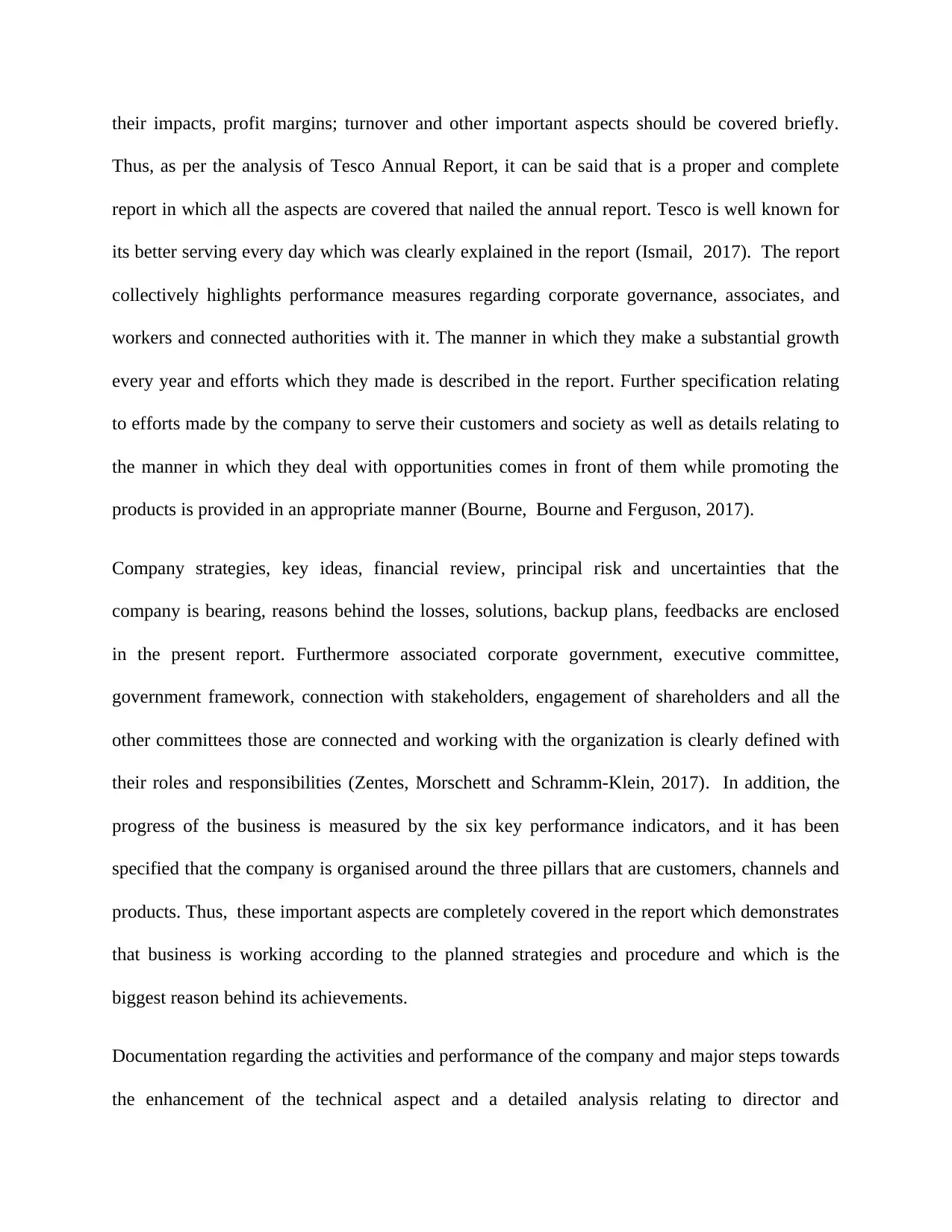
their impacts, profit margins; turnover and other important aspects should be covered briefly.
Thus, as per the analysis of Tesco Annual Report, it can be said that is a proper and complete
report in which all the aspects are covered that nailed the annual report. Tesco is well known for
its better serving every day which was clearly explained in the report (Ismail, 2017). The report
collectively highlights performance measures regarding corporate governance, associates, and
workers and connected authorities with it. The manner in which they make a substantial growth
every year and efforts which they made is described in the report. Further specification relating
to efforts made by the company to serve their customers and society as well as details relating to
the manner in which they deal with opportunities comes in front of them while promoting the
products is provided in an appropriate manner (Bourne, Bourne and Ferguson, 2017).
Company strategies, key ideas, financial review, principal risk and uncertainties that the
company is bearing, reasons behind the losses, solutions, backup plans, feedbacks are enclosed
in the present report. Furthermore associated corporate government, executive committee,
government framework, connection with stakeholders, engagement of shareholders and all the
other committees those are connected and working with the organization is clearly defined with
their roles and responsibilities (Zentes, Morschett and Schramm-Klein, 2017). In addition, the
progress of the business is measured by the six key performance indicators, and it has been
specified that the company is organised around the three pillars that are customers, channels and
products. Thus, these important aspects are completely covered in the report which demonstrates
that business is working according to the planned strategies and procedure and which is the
biggest reason behind its achievements.
Documentation regarding the activities and performance of the company and major steps towards
the enhancement of the technical aspect and a detailed analysis relating to director and
Thus, as per the analysis of Tesco Annual Report, it can be said that is a proper and complete
report in which all the aspects are covered that nailed the annual report. Tesco is well known for
its better serving every day which was clearly explained in the report (Ismail, 2017). The report
collectively highlights performance measures regarding corporate governance, associates, and
workers and connected authorities with it. The manner in which they make a substantial growth
every year and efforts which they made is described in the report. Further specification relating
to efforts made by the company to serve their customers and society as well as details relating to
the manner in which they deal with opportunities comes in front of them while promoting the
products is provided in an appropriate manner (Bourne, Bourne and Ferguson, 2017).
Company strategies, key ideas, financial review, principal risk and uncertainties that the
company is bearing, reasons behind the losses, solutions, backup plans, feedbacks are enclosed
in the present report. Furthermore associated corporate government, executive committee,
government framework, connection with stakeholders, engagement of shareholders and all the
other committees those are connected and working with the organization is clearly defined with
their roles and responsibilities (Zentes, Morschett and Schramm-Klein, 2017). In addition, the
progress of the business is measured by the six key performance indicators, and it has been
specified that the company is organised around the three pillars that are customers, channels and
products. Thus, these important aspects are completely covered in the report which demonstrates
that business is working according to the planned strategies and procedure and which is the
biggest reason behind its achievements.
Documentation regarding the activities and performance of the company and major steps towards
the enhancement of the technical aspect and a detailed analysis relating to director and
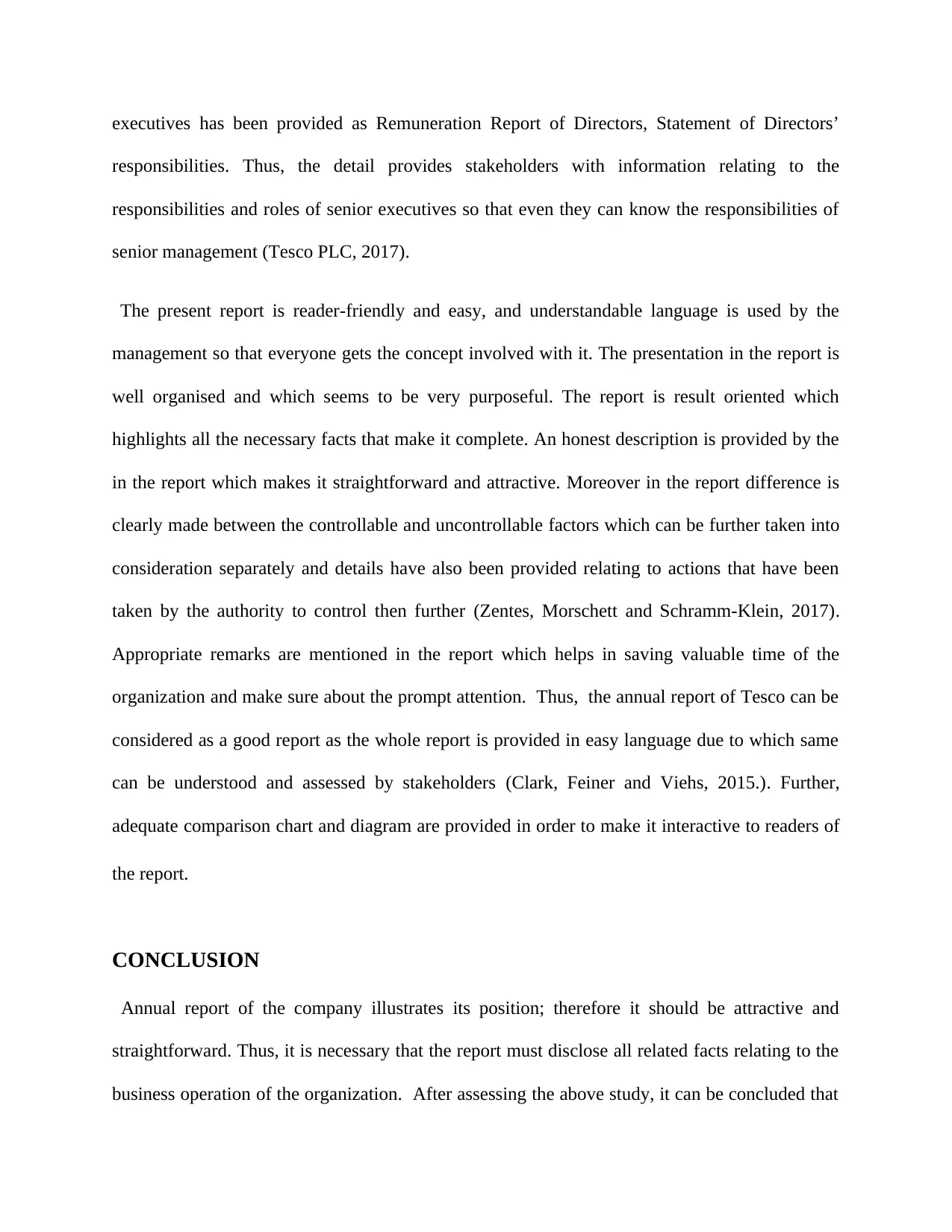
executives has been provided as Remuneration Report of Directors, Statement of Directors’
responsibilities. Thus, the detail provides stakeholders with information relating to the
responsibilities and roles of senior executives so that even they can know the responsibilities of
senior management (Tesco PLC, 2017).
The present report is reader-friendly and easy, and understandable language is used by the
management so that everyone gets the concept involved with it. The presentation in the report is
well organised and which seems to be very purposeful. The report is result oriented which
highlights all the necessary facts that make it complete. An honest description is provided by the
in the report which makes it straightforward and attractive. Moreover in the report difference is
clearly made between the controllable and uncontrollable factors which can be further taken into
consideration separately and details have also been provided relating to actions that have been
taken by the authority to control then further (Zentes, Morschett and Schramm-Klein, 2017).
Appropriate remarks are mentioned in the report which helps in saving valuable time of the
organization and make sure about the prompt attention. Thus, the annual report of Tesco can be
considered as a good report as the whole report is provided in easy language due to which same
can be understood and assessed by stakeholders (Clark, Feiner and Viehs, 2015.). Further,
adequate comparison chart and diagram are provided in order to make it interactive to readers of
the report.
CONCLUSION
Annual report of the company illustrates its position; therefore it should be attractive and
straightforward. Thus, it is necessary that the report must disclose all related facts relating to the
business operation of the organization. After assessing the above study, it can be concluded that
responsibilities. Thus, the detail provides stakeholders with information relating to the
responsibilities and roles of senior executives so that even they can know the responsibilities of
senior management (Tesco PLC, 2017).
The present report is reader-friendly and easy, and understandable language is used by the
management so that everyone gets the concept involved with it. The presentation in the report is
well organised and which seems to be very purposeful. The report is result oriented which
highlights all the necessary facts that make it complete. An honest description is provided by the
in the report which makes it straightforward and attractive. Moreover in the report difference is
clearly made between the controllable and uncontrollable factors which can be further taken into
consideration separately and details have also been provided relating to actions that have been
taken by the authority to control then further (Zentes, Morschett and Schramm-Klein, 2017).
Appropriate remarks are mentioned in the report which helps in saving valuable time of the
organization and make sure about the prompt attention. Thus, the annual report of Tesco can be
considered as a good report as the whole report is provided in easy language due to which same
can be understood and assessed by stakeholders (Clark, Feiner and Viehs, 2015.). Further,
adequate comparison chart and diagram are provided in order to make it interactive to readers of
the report.
CONCLUSION
Annual report of the company illustrates its position; therefore it should be attractive and
straightforward. Thus, it is necessary that the report must disclose all related facts relating to the
business operation of the organization. After assessing the above study, it can be concluded that
Secure Best Marks with AI Grader
Need help grading? Try our AI Grader for instant feedback on your assignments.
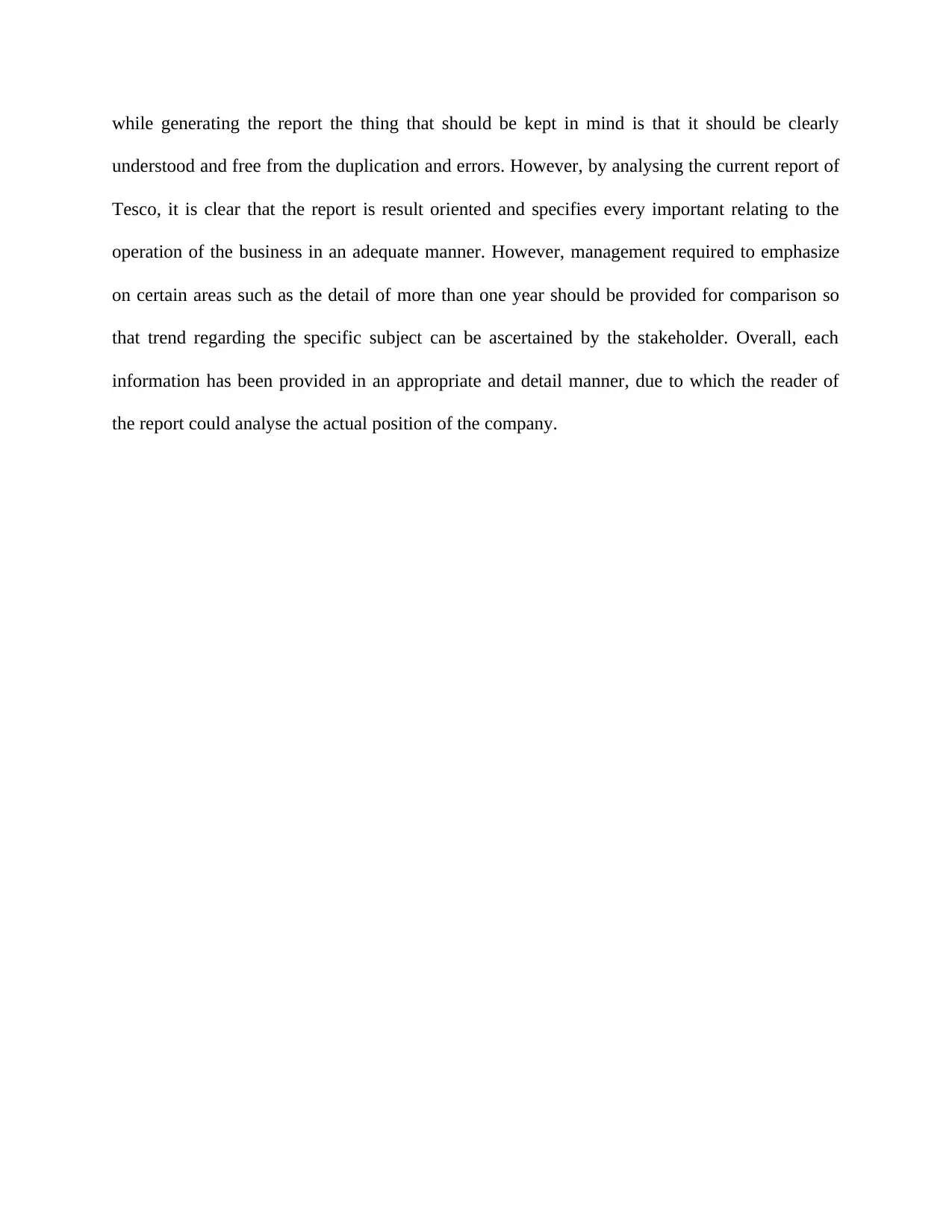
while generating the report the thing that should be kept in mind is that it should be clearly
understood and free from the duplication and errors. However, by analysing the current report of
Tesco, it is clear that the report is result oriented and specifies every important relating to the
operation of the business in an adequate manner. However, management required to emphasize
on certain areas such as the detail of more than one year should be provided for comparison so
that trend regarding the specific subject can be ascertained by the stakeholder. Overall, each
information has been provided in an appropriate and detail manner, due to which the reader of
the report could analyse the actual position of the company.
understood and free from the duplication and errors. However, by analysing the current report of
Tesco, it is clear that the report is result oriented and specifies every important relating to the
operation of the business in an adequate manner. However, management required to emphasize
on certain areas such as the detail of more than one year should be provided for comparison so
that trend regarding the specific subject can be ascertained by the stakeholder. Overall, each
information has been provided in an appropriate and detail manner, due to which the reader of
the report could analyse the actual position of the company.
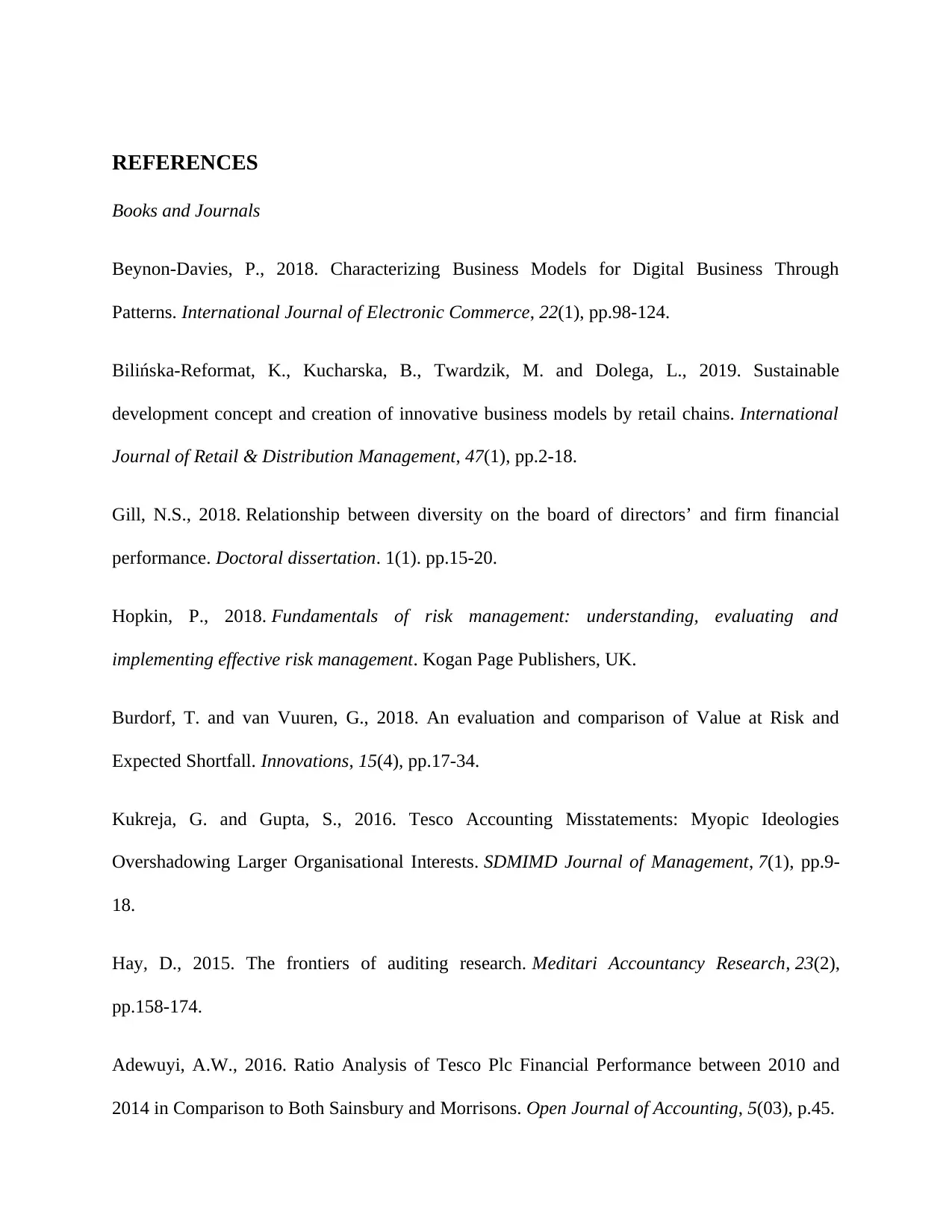
REFERENCES
Books and Journals
Beynon-Davies, P., 2018. Characterizing Business Models for Digital Business Through
Patterns. International Journal of Electronic Commerce, 22(1), pp.98-124.
Bilińska-Reformat, K., Kucharska, B., Twardzik, M. and Dolega, L., 2019. Sustainable
development concept and creation of innovative business models by retail chains. International
Journal of Retail & Distribution Management, 47(1), pp.2-18.
Gill, N.S., 2018. Relationship between diversity on the board of directors’ and firm financial
performance. Doctoral dissertation. 1(1). pp.15-20.
Hopkin, P., 2018. Fundamentals of risk management: understanding, evaluating and
implementing effective risk management. Kogan Page Publishers, UK.
Burdorf, T. and van Vuuren, G., 2018. An evaluation and comparison of Value at Risk and
Expected Shortfall. Innovations, 15(4), pp.17-34.
Kukreja, G. and Gupta, S., 2016. Tesco Accounting Misstatements: Myopic Ideologies
Overshadowing Larger Organisational Interests. SDMIMD Journal of Management, 7(1), pp.9-
18.
Hay, D., 2015. The frontiers of auditing research. Meditari Accountancy Research, 23(2),
pp.158-174.
Adewuyi, A.W., 2016. Ratio Analysis of Tesco Plc Financial Performance between 2010 and
2014 in Comparison to Both Sainsbury and Morrisons. Open Journal of Accounting, 5(03), p.45.
Books and Journals
Beynon-Davies, P., 2018. Characterizing Business Models for Digital Business Through
Patterns. International Journal of Electronic Commerce, 22(1), pp.98-124.
Bilińska-Reformat, K., Kucharska, B., Twardzik, M. and Dolega, L., 2019. Sustainable
development concept and creation of innovative business models by retail chains. International
Journal of Retail & Distribution Management, 47(1), pp.2-18.
Gill, N.S., 2018. Relationship between diversity on the board of directors’ and firm financial
performance. Doctoral dissertation. 1(1). pp.15-20.
Hopkin, P., 2018. Fundamentals of risk management: understanding, evaluating and
implementing effective risk management. Kogan Page Publishers, UK.
Burdorf, T. and van Vuuren, G., 2018. An evaluation and comparison of Value at Risk and
Expected Shortfall. Innovations, 15(4), pp.17-34.
Kukreja, G. and Gupta, S., 2016. Tesco Accounting Misstatements: Myopic Ideologies
Overshadowing Larger Organisational Interests. SDMIMD Journal of Management, 7(1), pp.9-
18.
Hay, D., 2015. The frontiers of auditing research. Meditari Accountancy Research, 23(2),
pp.158-174.
Adewuyi, A.W., 2016. Ratio Analysis of Tesco Plc Financial Performance between 2010 and
2014 in Comparison to Both Sainsbury and Morrisons. Open Journal of Accounting, 5(03), p.45.
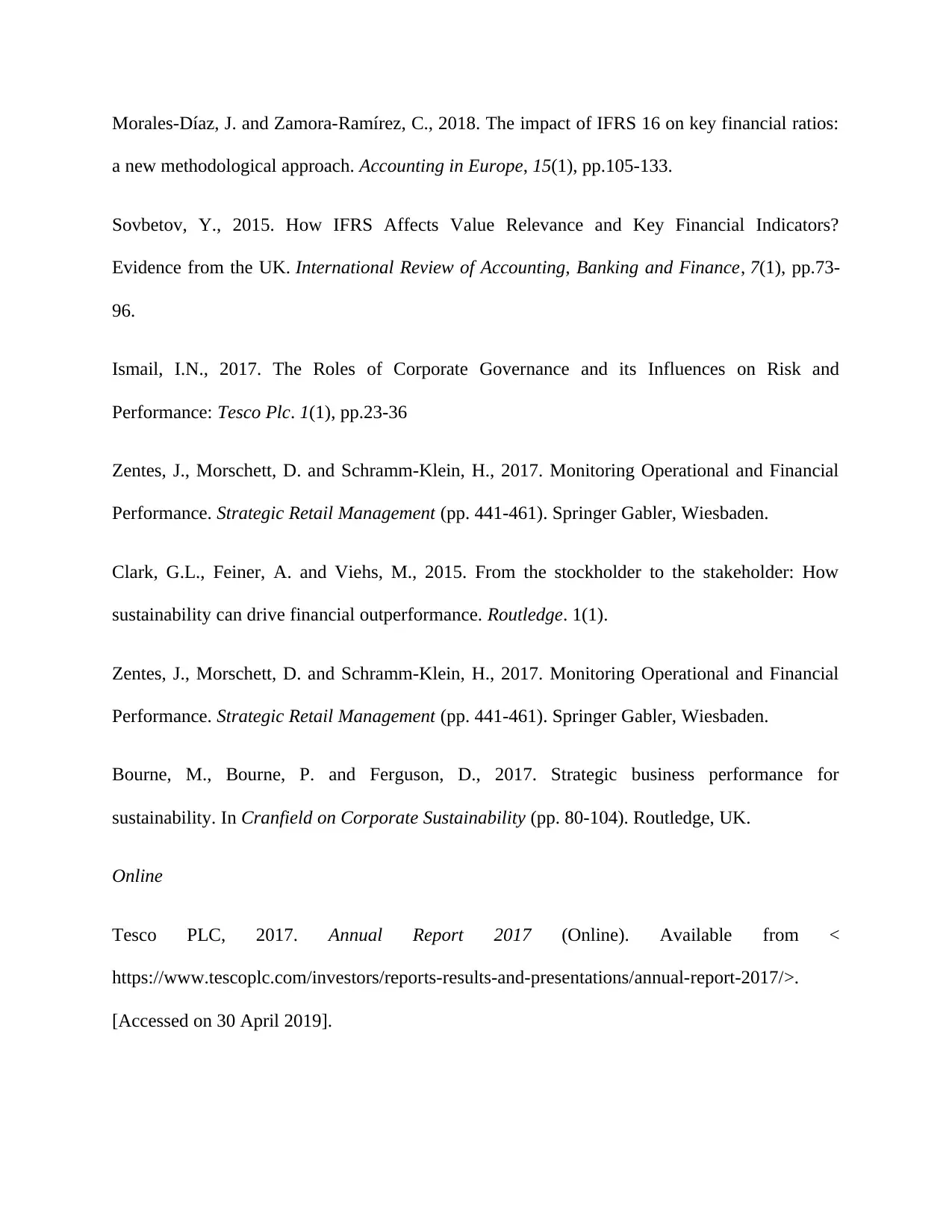
Morales-Díaz, J. and Zamora-Ramírez, C., 2018. The impact of IFRS 16 on key financial ratios:
a new methodological approach. Accounting in Europe, 15(1), pp.105-133.
Sovbetov, Y., 2015. How IFRS Affects Value Relevance and Key Financial Indicators?
Evidence from the UK. International Review of Accounting, Banking and Finance, 7(1), pp.73-
96.
Ismail, I.N., 2017. The Roles of Corporate Governance and its Influences on Risk and
Performance: Tesco Plc. 1(1), pp.23-36
Zentes, J., Morschett, D. and Schramm-Klein, H., 2017. Monitoring Operational and Financial
Performance. Strategic Retail Management (pp. 441-461). Springer Gabler, Wiesbaden.
Clark, G.L., Feiner, A. and Viehs, M., 2015. From the stockholder to the stakeholder: How
sustainability can drive financial outperformance. Routledge. 1(1).
Zentes, J., Morschett, D. and Schramm-Klein, H., 2017. Monitoring Operational and Financial
Performance. Strategic Retail Management (pp. 441-461). Springer Gabler, Wiesbaden.
Bourne, M., Bourne, P. and Ferguson, D., 2017. Strategic business performance for
sustainability. In Cranfield on Corporate Sustainability (pp. 80-104). Routledge, UK.
Online
Tesco PLC, 2017. Annual Report 2017 (Online). Available from <
https://www.tescoplc.com/investors/reports-results-and-presentations/annual-report-2017/>.
[Accessed on 30 April 2019].
a new methodological approach. Accounting in Europe, 15(1), pp.105-133.
Sovbetov, Y., 2015. How IFRS Affects Value Relevance and Key Financial Indicators?
Evidence from the UK. International Review of Accounting, Banking and Finance, 7(1), pp.73-
96.
Ismail, I.N., 2017. The Roles of Corporate Governance and its Influences on Risk and
Performance: Tesco Plc. 1(1), pp.23-36
Zentes, J., Morschett, D. and Schramm-Klein, H., 2017. Monitoring Operational and Financial
Performance. Strategic Retail Management (pp. 441-461). Springer Gabler, Wiesbaden.
Clark, G.L., Feiner, A. and Viehs, M., 2015. From the stockholder to the stakeholder: How
sustainability can drive financial outperformance. Routledge. 1(1).
Zentes, J., Morschett, D. and Schramm-Klein, H., 2017. Monitoring Operational and Financial
Performance. Strategic Retail Management (pp. 441-461). Springer Gabler, Wiesbaden.
Bourne, M., Bourne, P. and Ferguson, D., 2017. Strategic business performance for
sustainability. In Cranfield on Corporate Sustainability (pp. 80-104). Routledge, UK.
Online
Tesco PLC, 2017. Annual Report 2017 (Online). Available from <
https://www.tescoplc.com/investors/reports-results-and-presentations/annual-report-2017/>.
[Accessed on 30 April 2019].
Paraphrase This Document
Need a fresh take? Get an instant paraphrase of this document with our AI Paraphraser
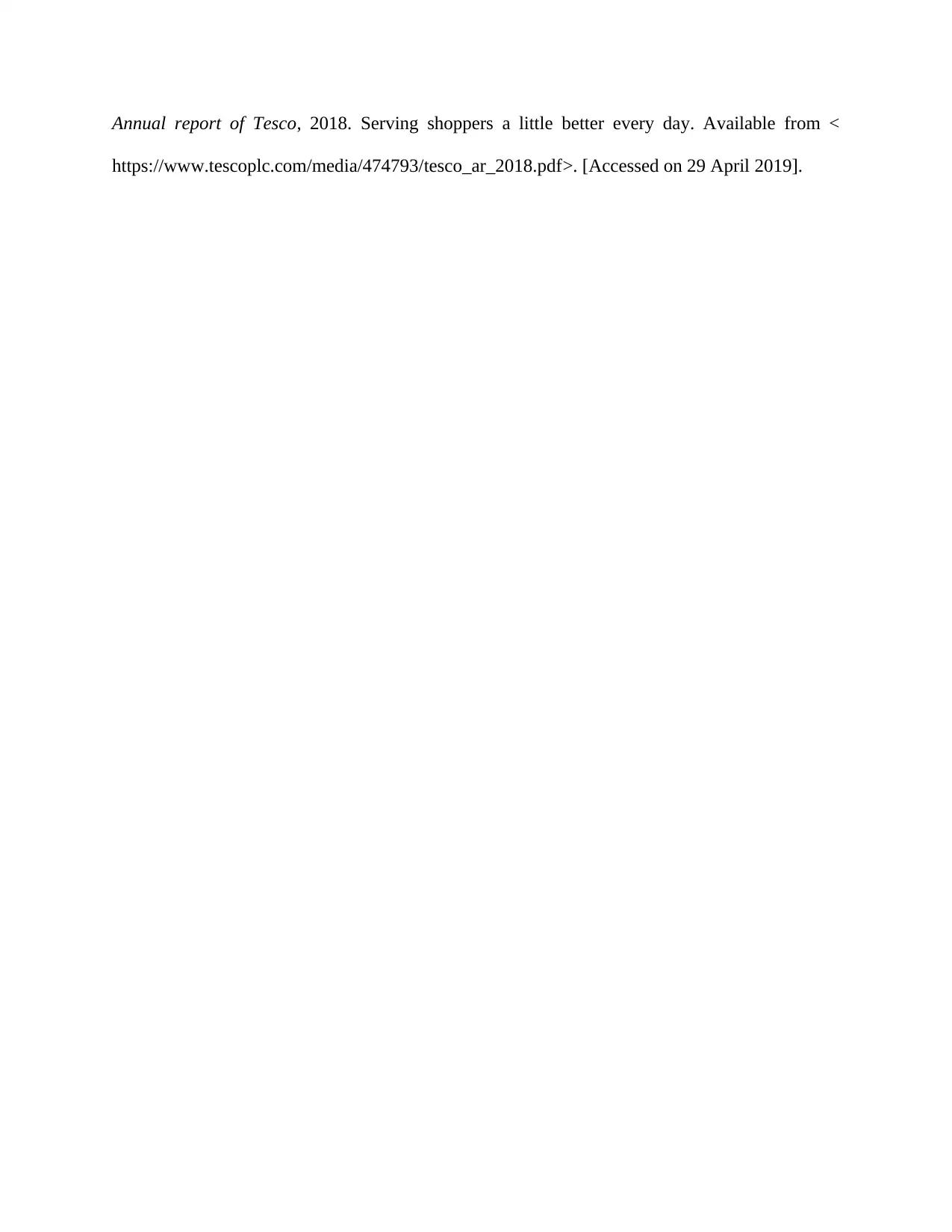
Annual report of Tesco, 2018. Serving shoppers a little better every day. Available from <
https://www.tescoplc.com/media/474793/tesco_ar_2018.pdf>. [Accessed on 29 April 2019].
https://www.tescoplc.com/media/474793/tesco_ar_2018.pdf>. [Accessed on 29 April 2019].
1 out of 14
Related Documents
Your All-in-One AI-Powered Toolkit for Academic Success.
+13062052269
info@desklib.com
Available 24*7 on WhatsApp / Email
![[object Object]](/_next/static/media/star-bottom.7253800d.svg)
Unlock your academic potential
© 2024 | Zucol Services PVT LTD | All rights reserved.




